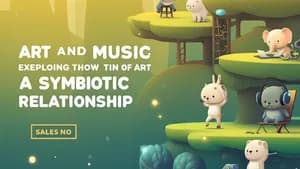Digital Convergence: Exploring the Intersection of Art and Music in the Digital Age
In the dynamic landscape of the 21st century, technology has become an integral force in reshaping the boundaries between disciplines. This is particularly evident in the convergence of art and music, where digital tools have opened up unprecedented possibilities for creative expression and collaboration. As we delve into the world of digital convergence, you'll discover how this evolution is not only revolutionizing the way we experience art and music but also fostering new avenues for artistic innovation and learning.
The Rise of Interactive Art Installations
Imagine stepping into a room where your movements trigger changes in light, sound, and visual projections. This is the captivating world of interactive art installations, a perfect example of digital convergence. These installations, often incorporating sensors, software, and digital projections, allow viewers to become active participants in the artwork.
As a student, you can harness the power of interactive art installations to enhance your understanding of art and technology. Consider exploring these installations at local museums or art centers. While experiencing them, think about the role of technology in creating the immersive effect. How do sensors, software, and other digital elements contribute to the artwork's dynamic nature? By analyzing these aspects, you can gain valuable insights into the creative process and the influence of technology in shaping artistic expression.
Digital Music Visualization: A Symphony for the Eyes
The rise of digital music visualization has transformed the way we listen to and interact with music. Visualizations often use algorithms and software to translate the sonic properties of music into captivating visual displays. These displays can range from simple waveforms to complex, abstract animations, each responding to the nuances of the music.
As students, exploring these visualizations can provide a deeper understanding of music's structure and composition. Software programs like Audacity or Logic Pro allow you to create your own visualizations, experimenting with different parameters and seeing how they impact the visual output. This hands-on approach can be a fun and engaging way to learn about the elements of music, such as rhythm, harmony, and melody.
The Collaborative Power of Digital Tools
Digital tools have revolutionized collaboration in the arts, making it easier for artists and musicians to connect, share ideas, and work together on projects regardless of geographical location. From online platforms like SoundCloud and Bandcamp to collaborative software like Google Docs and Figma, digital tools facilitate the exchange of ideas and the creation of shared masterpieces.
As a student, embrace the power of collaboration by working on joint projects with classmates or friends. Use online platforms to share your work, receive feedback, and connect with like-minded individuals. This collaborative process can foster a sense of community, spark new ideas, and broaden your artistic horizons.
The Future of Art and Music: A Digital Fusion
The convergence of art and music in the digital age continues to evolve at a rapid pace. Emerging technologies like augmented and virtual reality are pushing the boundaries of artistic expression, allowing viewers to interact with artworks in entirely new ways. Artificial intelligence is also playing an increasing role, generating music and art, and pushing the limits of what is possible.
As you move forward in your learning journey, stay curious and explore the exciting possibilities of digital art and music. Experiment with different technologies, learn new skills, and don't be afraid to push the boundaries of your creativity. The digital age offers a vast and ever-expanding canvas for you to express yourself, collaborate, and create impactful works of art and music.
Conclusion
The convergence of art and music in the digital age is a testament to the transformative power of technology. It's not just about merging different disciplines; it's about creating new avenues for creative expression, collaboration, and learning. As students, you are at the forefront of this evolution. Embrace the tools, explore the possibilities, and let your imagination guide you in the world of digital convergence.

